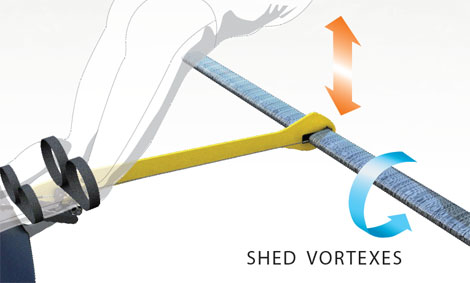Navy SEALs Could Turn Superhuman with Pentagon's PowerSwim
America's underwater special forces ops might not like it at first, but this dolphin-like device will let them reach targets fast—and without having to catch their breath.

The device is compatible with standard scuba gear, as well as the front-mounted rebreathers (artist sketch, above) used by special operations personnel to avoid telltale bubble trails.
By Erik Sofge
Illustration by Translucent.de
Published in the November 2007 issue.
Humans are terrible swimmers, converting roughly 3 percent of their kicks, strokes and general underwater exertions into forward motion. We can boost our efficiency to 10 percent by adding fins, but dolphins, by comparison, can turn 80 percent of their energy into thrust. Not to be outdone, the Pentagon’s research wing, DARPA, is developing a contraption that lets Navy SEALs and other combat divers swim faster, and with less effort.
Instead of kicking, PowerSwim calls for a kind of undulation as its hinged foils pivot up and down. Similar to the way a dolphin or tortoise pumps its fins, this motion generates both lift and thrust. And while artificial fins operate within the swimmer’s own wake (they form a kind of expanding cone, starting at a swimmer’s shoulders), the PowerSwim’s lead foil—or propulsor foil—sweeps through the water just outside that wake.
When used properly, the device allows swimmers to cover a given distance up to 150 percent faster than with fins, while using the same amount of energy. Much of that boost in metabolic efficiency is due to the muscle groups used. As DARPA program manager Barbara McQuiston explained, the swimmer is essentially relaxing into a slightly bent position, instead of forcing or pushing the foils through the water. This takes the emphasis off the small muscle groups used to kick, and allows larger muscle groups, such as the glutes and quads, to take over. During tests, it typically took around 2 hours for Navy SEALs to fight the urge (and years of training) to move forcefully and learn the PowerSwim’s unique motion.
If the device is widely used, it could be a huge benefit for combat divers, letting SEALs reach coastal targets without becoming over-exhausted. The goal isn’t to increase the total distance that personnel can cover, but to get them there more quickly, and with more energy. Depending on the mission, swimmers might dump the PowerSwim, along with rebreathers and other gear, before setting foot on land.
And unlike many DARPA programs, PowerSwim is coming soon—McQuiston says that the device is at the packaging stage, as researchers determine how to possibly fold or other*wise reduce its overall footprint, to allow for more efficient transport. Full production units could be deployed within a year.
How It Works

The seesaw movement of the foils creates rolling currents, called shed vortexes, that sweep back and around to push the foil forward. It’s a phenomenon exploited by various aquatic species, such as penguins and dolphins. (Illustration by Gil Ahn)
Interesting article from Popular Mechanics.
